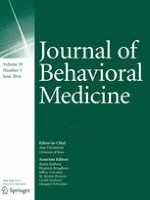31-12-2015
Do hassles and uplifts trajectories predict mortality? Longitudinal findings from the VA Normative Aging Study
Gepubliceerd in: Journal of Behavioral Medicine | Uitgave 3/2016
Log in om toegang te krijgenAbstract
We examined whether longitudinal patterns of hassles and uplifts trajectories predicted mortality, using a sample of 1315 men from the VA Normative Aging Study (mean age = 65.31, SD = 7.6). In prior work, we identified different trajectory classes of hassles and uplifts exposure and intensity scores over a period of 16 years. In this study, we used the probabilities of these exposure and intensity class memberships to examine their ability to predict mortality. Men with higher probabilities of high hassle intensity trajectory class and high uplift intensity class had higher mortality risks. In a model combining the probabilities of hassle and uplift intensities, the probability of high intensity hassle class membership significantly increased the risk of mortality. This suggests that appraisals of hassles intensity are better predictors of mortality than simple exposure measures, and that uplifts have no independent effects.
